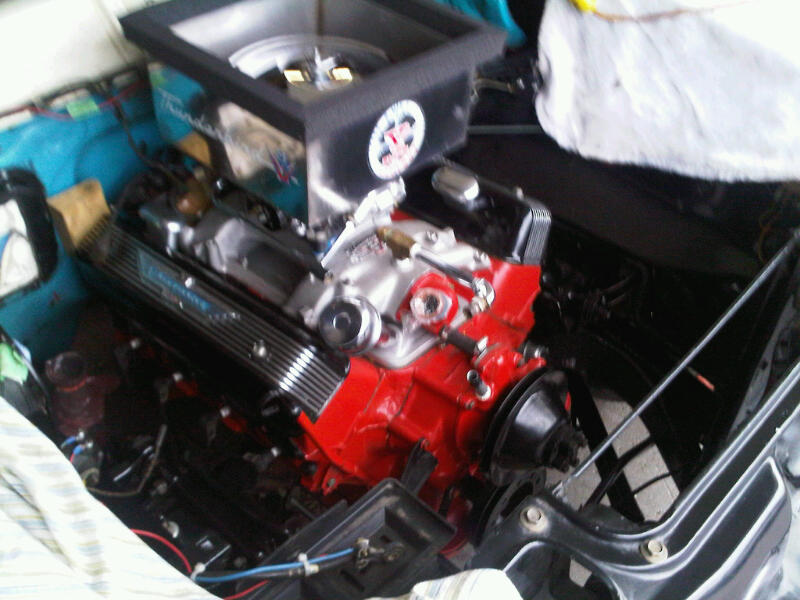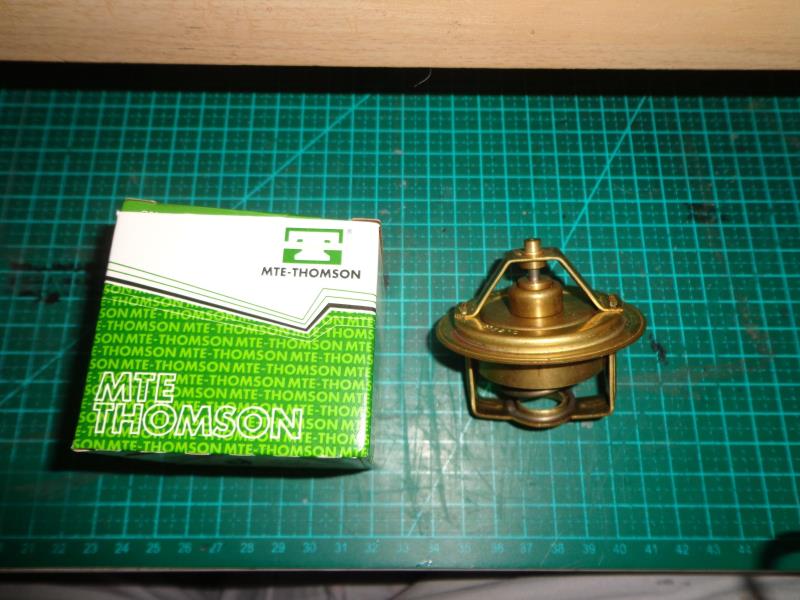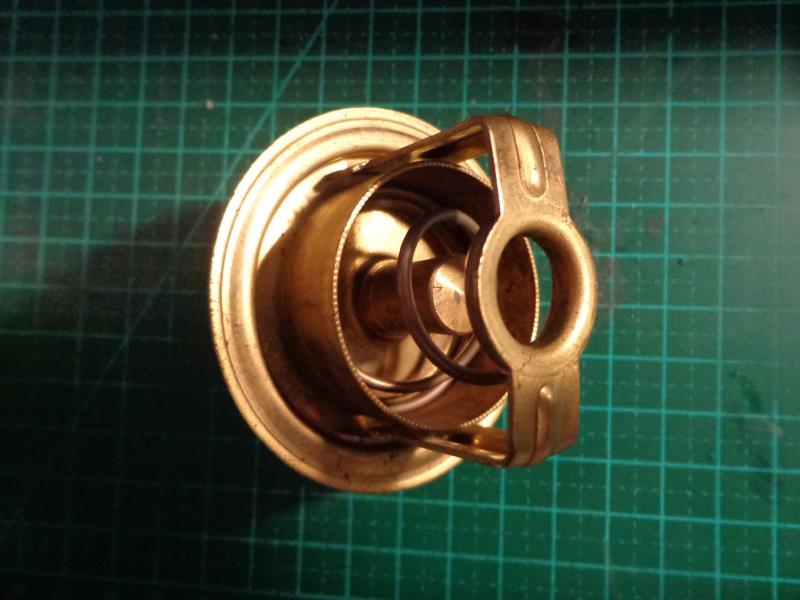|
By lovefordgalaxie - 11 Years Ago
|
Howdy to you all.
I'm in a dilemma here. I'm running a Robertshaw (genuine stuff, not made in China) 160 degree thermostat on my 292, that is bored 0.060 over, has a Isky E-4 and a Autolite four barrel.
People say I should replace it with a 180 degree thermostat, because 160 is "too cold".
Well, the car runs great, and my climate here is humid and hot, like let's say Florida (being there, and it was VERY familiar, hahaha)
My engine almost never goes beyond 170 while driving on normal speed traffic, with a occasional 200 when stuck in traffic.
What do you guys think?
|
|
By paul2748 - 11 Years Ago
|
I have either a 160 or 170 thermostat (can't remember which one) and my car runs good.
|
|
By Talkwrench - 11 Years Ago
|
|
180 is probably better , but so long as you are not doing short drives and you do show 180+ and maintain it for some time I think your fine.
|
|
By charliemccraney - 11 Years Ago
|
A hotter engine is a more efficient and powerful engine. If your cooling system is adequate and in good condition, it will not overheat. I'm in Atlanta, not too far from Florida, your analog to your location, and run a 180.
|
|
By lovefordgalaxie - 11 Years Ago
|
Thanks for the imput guys.
Since I had a overheating problem before rebuilding the engine, I'm kind of scared of hot water boiling and hissing all over the engine bay.
Thanks Charley, what you said is what I red and also was told.
My bigger worry tough is having a significant engine wear issue due to the 160 T-Stat.
|
|
By 62bigwindow - 11 Years Ago
|
|
How will a 160 T-Stat cause premature engine wear? I am asking because I think that is what I just bought to put in my 292.
|
|
By Ted - 11 Years Ago
|
|
There has been plenty of testing on stationary engines in the past that supports the warmer coolant temperatures promoting less engine wear. Part of this has to do with getting the oil warmer which in turn simply flows better in lubing all the various parts; cooler oil just doesn’t circulate as well. Warmer combustion temperatures are also more efficient in that more of the atomized fuel is burned. Colder engines require a richer fuel mixture which is also promotes quicker wear due to ‘fuel wash’ at the rings and cylinders.
|
|
By lovefordgalaxie - 11 Years Ago
|
I got the 160 because it's a Robertshaw, so it's big. The 180 t-stats I find here are all too restrictive.
I'll look for a Robertshaw kind, the so called high volume nowadays with 180 opening.
|
|
By GREENBIRD56 - 11 Years Ago
|
Tulio - I believe that because your "normal equilibrium" temperatures are the 170º (and highest at 200º) as reported, changing to the 180º will only change the bottom end. It will pull up the 170º to the 180º where the T-stat is actually regulating it. Upper end temp therefore shouldn't change - as in both cases (160º or 180º) the T-stats should both be wide open there. Sometimes it can be difficult to find a t-stat that regulates smoothly - and they won't set down at the opening point and stay there and wander a bit.
Narrowing that range of operation should be better for simply setting up the engine to have a more consistent idle performance. I've thought before, that I wouldn't mind finding a 190º if I could find one that was stable and didn't hunt. much easier to set the idle for all weather conditions.
|
|
By Canadian Hot Rodder - 11 Years Ago
|
Interesting thread!
When I built my motor, based on the higher compression on the iron heads I figured it would be wise to run a cooler (160 deg F) thermostat! I guess I was wrong! I find that my engine runs excessively cool as long as I am moving, but likes to climb pretty fast when I am idling. I am running an aluminum rad with Mr Gasket "Blow through" electric fan on a 190 deg temp switch. I think I may go back to the prop fan and keep the electric as a back up. I am questioning the amount of CFM that the electric fan is pushing through.
So based on this thread, I am best to go back to a 180 Deg stat, as that should keep my Y in a better operating range?
|
|
By charliemccraney - 11 Years Ago
|
Rob, I found that the stock car pulley is too big to cool well at low rpm - the pump turns to slowly. Try a smaller diameter pulley. Make it 1:1 with the crank pulley (6 5/8" if using the stock damper) or smaller, but not so small that it exceeds 7000 rpm when you race. I have not had idle cooling issues since changing to a smaller water pump pulley.
|
|
By charliemccraney - 11 Years Ago
|
I disagree with the blanket statement that electric fans don't do much work. CFM is CFM whether it is driven by a belt or electric motor. There are so many sizes and flow options for electric fans that it is real easy to choose one that is not sufficient for the job. That doesn't mean an electric fan can't handle the job. It means you picked the wrong fan. Electric fans are factory equipped in millions of cars, of all power levels and cool them just fine.
There is also a cost issue, and like many things, you get what you pay for with electric fans - at not more than $120 on Summit, I'd question a Mr Gasket fan, too, and that is another good thing to investigate.
|
|
By lovefordgalaxie - 11 Years Ago
|
Well, I looked at every single store both "real" and virtual, and only found the Stant T-Stat that is as tight as a virgin, and has a really bad reputation around here. The water passage is a hair bigger than the outside of the bypass hose!!! Will keep the 160 until I can find a decent 180 T-Stat, or decide to import one from the U.S.
That's why the guys that have Mopars all use 160 degree T-Stats here... I can find as many as I wish, and all the high flow/Robershaw kind.
On the water pump pulley, Ford uses a small one on Brazilian Ys. The temperature rises when at idle on traffic, but it takes a while, and that has nothing to do with the T-Stat, because both the 180 and 160 would be fully open after 180 degrees.
|
|
By Canadian Hot Rodder - 11 Years Ago
|
Charlie,
I used to run both, electric & mechanical fan on my motor ( just operated the electric on a toggle if it got hot at idle). I may go back to that. I installed my temp switch for the electric fan off a brass tee, right off the intake behind the thermostat. ( I control the heater with manual valves. ) The only issue with this, is I had to install a bypass valve, between the heater hoses, to allow flow past the switch when the heater core is closed off.

|
|
By charliemccraney - 11 Years Ago
|
It looks like your water pump pulley is a smaller than stock pulley, so coolant flow through the radiator is probably ok. It probably is airflow.
|
|
By Doug T - 11 Years Ago
|
Another thing that helps cooling is to restrict the flow in the bypass which is the small short section of heater hose between the Tstat housing and the water pump. This is always bypassing the radiator returning hot water to the pump intake. All you need is a small scrap of sheet metal drilled for the bolts to the water pump and then a hole for reduced flow into the pump I think I have used 1/4" hole in the flow area. This will slow heat up on a cool day but improve water flow through the radiator and thus bring down the water temp returning to the engine.
BTW I agree with the idea of a 190F thermostat if it can be found.
|
|
By lovefordgalaxie - 11 Years Ago
|
Found a thermostat!!
And it's from the original FoMoCo supplier (MTE Thomson). They still made them, with the Ford Galaxie on the application on their catalog. Opening temp is 80º Celsius, that's what Ford requires.
Just installed it. Now wainting for the RTV I used on the gasket to set.
  
|
|
By Rono - 11 Years Ago
|
Ted/Charlie;
I am a bit confused here; While warmer oil and higher operating temperatures may be more effective in preventing engine wear, I was always under the impression that a cooler fuel/air mix being more dense that a warm fuel/air mix provided a better detonation. So how do operate a hotter engine while keeping the fuel mixture cooler? "Cool Cans" were used back in the day, but you don't see them anymore.
Rono
|